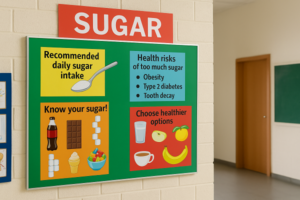GS2 – Social Sector

Context:
CBSE, with support from the National Commission for Protection of Child Rights (NCPCR), is set to mandate ‘Sugar Boards’ in schools to raise awareness about sugar consumption and related health risks.
About Sugar Boards
Visual learning aids installed in schools to:
- Highlight sugar content in packaged foods (e.g., sodas, juices, chocolates) in teaspoons/grams.
- Share WHO guidelines: Limit daily sugar intake to 25g (≈6 teaspoons).
- Educate about health risks of excess sugar:
→ Obesity
→ Type-2 Diabetes
→ Tooth Decay
→ Metabolic Disorders - Promote healthier alternatives:
→ Fresh fruits
→ Infused water
→ Traditional low-sugar snacks - Involve students in interactive activities:
→ Sugar content calculations
→ Infographic creation
Need for Sugar Boards
- Rising Childhood Diabetes: India ranks 2nd globally, reporting 397 Type-2 diabetes cases per lakh children.
- Excess Sugar Intake: Indian children get 13–15% of daily calories from sugar (vs WHO’s recommended <5%).
- Unhealthy Food Environments: Processed, sugary foods widely accessible near schools.
- Poor Nutrition Education: Current curriculum is theoretical and fails to engage students meaningfully.
Regulatory Gaps
- FSSAI yet to finalize norms for High Fat, Salt, Sugar (HFSS) foods in schools.
- Health Star Rating (HSR) under development:
→ Based on positive vs negative nutrients
→ Meant to help consumers make healthier choices - WHO’s definition of “low sugar” (≤5g per 100g) is used only for labelling, not intake norms.
- India lacks context-specific dietary benchmarks based on:
→ BMI
→ Insulin resistance
→ Lipid profiles




